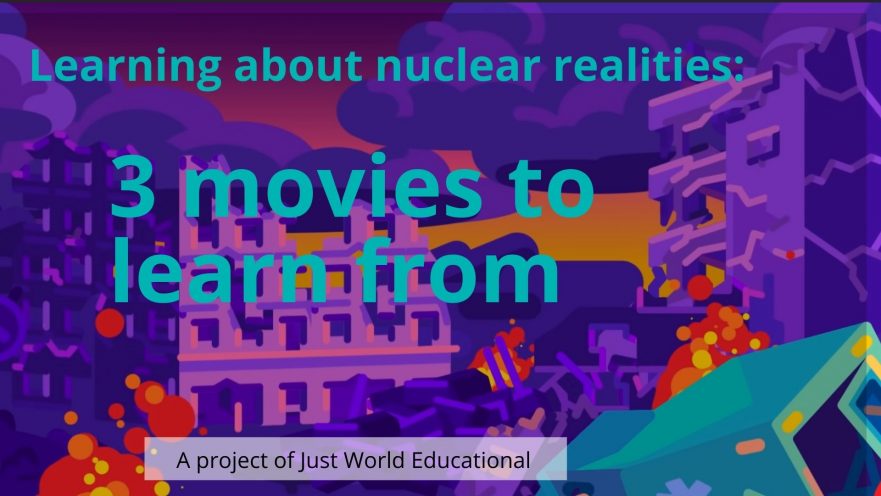In the lead-up to the mid-June Meeting of States Parties to the Treaty on the Prohibition of Nuclear Weapons (TPNW), we’re presenting a series of materials to help new generations understand the risks and realities arising from the reliance of the United States, Russia, and seven other nations on omnicidal nuclear-weapons arsenals. You can find all these materials here.
This blog post introduces (or revisits) three movies that can act as great starting-points for any family or community group that wants to learn about the risks of nuclear war. They are:
- Stanley Kubrick’s 1964 classic Dr. Strangelove or: How I Learned to Stop Worrying and Love the Bomb (94 minutes)
- Nicholas Meyer’s 1983 movie The Day After (2 hrs 6 minutes)
- The ICRC/Kurzgesagt’s 2019 animated short What if we Nuke a City? (9 minutes)
The latter two of these films are available free-of-charge and at full length on Youtube, at the links indicated. Dr. Strangelove is available for download from Amazon. Here are program notes for all three of them, in reverse chronological order.
What if we Nuke a City?
This movie was commissioned by the Geneva-based International Committee of the Red Cross (ICRC) from ‘Kurzgesagt/In a nutshell’, a Munich-based animation studio. It sets out to show members of the videogame-playing generations that concepts like “nuclear fireball” or “radiation” that they may throw around in some of the more violent games they play have relevance not just in the world of gaming, but are also the actual risks that real people would face in any (still-possible) nuclear war.
The plot-line of the movie is simple. It takes viewers through the likely sequence of events if just one nuclear weapon is used against one, seemingly mid-sized, city. These effects start with the near-instantaneous destruction of all people and buildings within a kilometer of the blast and take us through the electromagnetic and nuclear-wind effects that blind people and collapse buildings around in the 70 or so square miles around the explosion, through the collapse of all nearby infrastructure, and ends up with a massive pall of radioactive debris blanketing an area far larger than the city itself. At the end, the narrator (and the visuals) explain that, “It’s not about who has nuclear weapons and who doesn’t. The weapons themselves are the problem.” The film finishes with a strong pitch for the TPNW.

As of today, 24.3 million people have viewed What if we Nuke a City? on Youtube.
Soon after the film’s October 2019 release, it had already racked up nine million views. Enrique Mestre, the lead for the ICRC’s Nuclear Weapon Ban campaign, said, “The fact that millions of people have watched this video in the very short time since its release shows that people care about this issue, and people should care about the menace nuclear weapons pose. Seventy-four years after the bombings of the Japanese cities of Hiroshima and Nagasaki, the risk that nuclear weapons will be used again is growing. We at the ICRC think this video will change minds about the importance of confronting the threat of nuclear weapons.”
The ICRC has been one of the leaders of the global campaign to ban nuclear weapons. Check out their “No to Nukes” resource page here.
We are very grateful to the ICRC and Kurzgesagt for having produced this great educational tool. We also acknowledge that we are using some art from it in the logo for our present “Nuclear Realities” project.
The Day After
This 126-minute film was made by ABC’s (since disbanded) films division and was aired on November 20, 1983. Wikipedia tells us that “More than 100 million people, in nearly 39 million households, watched the program during its initial broadcast.” It was made in a very down-home, realist style but had roughly the same apparent intent as the ICRC/Kurzgesagt production, namely, to bring home to a broad viewership the terrible effects that any nuclear war would have on the residents of the area targeted.

The ABC team that made the movie used Lawrence, Kansas as their prime location and lined up an powerful cast including JoBeth Williams, Steve Guttenberg, John Cullum, Jason Robards, and John Lithgow. Their choice of a location allowed the movie to feature people in a mid-size city, including college students, workers in a hospital, and journalists in a packed newsroom (remember those?) It also allowed them to show people on nearby farms and on a nearby air-base housing B-52 bombers of the Strategic (nuclear) Air Command.
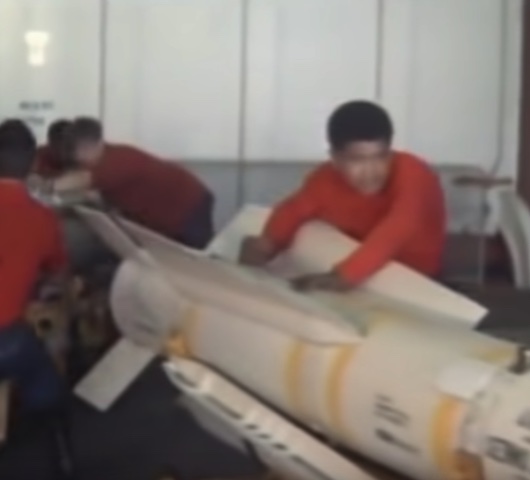
The first half of the movie depicts these people going about their everyday tasks, during which time several small personal plot-lines develop that enable us to “identify” with these people and their concerns. But all that happens amid rising fears of a nuclear confrontation against the Soviet Union.
Then, after roughly one hour, all hell breaks loose as the (presumably Soviet) nuclear missiles approach then start landing. The mechanics on the air base scramble to load nuclear bombs into the B-52s and get them off the ground and into the sky before they can be hit. We see the commander of a bomber in his cockpitb undoing the seal that protects the special codes needed in order to drop his bombs. But most of the second half of the movie shows us what is happening on the ground, in and around the city, after the incoming bombs have hit. It is, of course, a very grim picture, as nearly all the city’s systems suffer rapid collapse and chaos, and gangs of desperate survivors turn on each other and the few authority figures who are left.
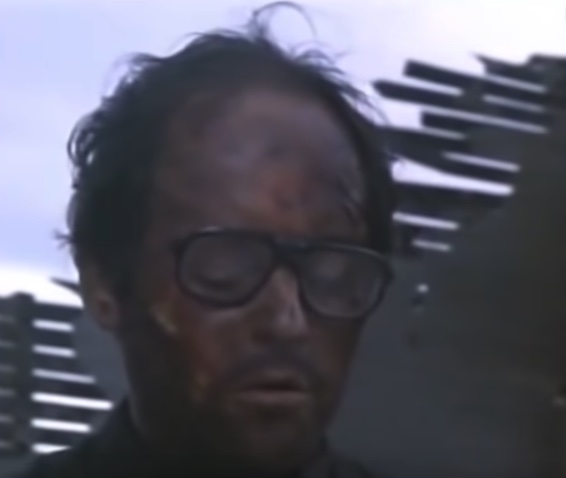
As Wikipedia tells us: “The film ends as Lawrence science faculty head Joe Huxley repeatedly tries to contact other survivors with a shortwave radio. There is no response.”
The Wikipedia page about this film is definitely worth reading. About the making of the film, we learn that:
ABC, which financed the production, was concerned about the graphic nature of the film and how to appropriately portray the subject on a family-oriented television channel. [Veteran tv writer Edward] Hume undertook a massive amount of research on nuclear war and went through several drafts until finally ABC deemed the plot and characters acceptable.
… [Director Nicholas] Meyer plunged into several months of nuclear research, which made him quite pessimistic about the future, to the point of becoming ill each evening when he came home from work. Meyer and [producer Robert] Papazian also made trips to the ABC censors, and to the United States Department of Defense during their research phase, and experienced conflicts with both. Meyer had many heated arguments over elements in the script that the network censors wanted cut out of the film. The Department of Defense said they would cooperate with ABC if the script made clear that the Soviet Union launched their missiles first—something Meyer and Papazian took pains not to do.
At the time it came out– as I remember– this film was a massive event. (Remember that there was still a very large anti-nuclear movement throughout the whole United States at that time.)
Wikipedia tells us this:
On its original broadcast… John Cullum warned viewers before the film was premiered that the film contains graphic and disturbing scenes, and encouraged parents who have young children watching, to watch together and discuss the issues of nuclear warfare. ABC and local TV affiliates opened 1-800 hotlines with counselors standing by. There were no commercial breaks after the nuclear attack. ABC then aired a live debate on Viewpoint, ABC’s occasional discussion program hosted by Nightline‘s Ted Koppel, featuring scientist Carl Sagan, former Secretary of State Henry Kissinger, Elie Wiesel, former Secretary of Defense Robert McNamara, General Brent Scowcroft and commentator William F. Buckley Jr. Sagan argued against nuclear proliferation, while Buckley promoted the concept of nuclear deterrence. Sagan described the arms race in the following terms: “Imagine a room awash in gasoline, and there are two implacable enemies in that room. One of them has nine thousand matches, the other seven thousand matches. Each of them is concerned about who’s ahead, who’s stronger.”
Also, this:
U.S. President Ronald Reagan watched the film more than a month before its screening on Columbus Day, October 10, 1983. He wrote in his diary that the film was “very effective and left me greatly depressed” and that it changed his mind on the prevailing policy on a “nuclear war”. The film was also screened for the Joint Chiefs of Staff… In 1987, Reagan and Soviet leader Mikhail Gorbachev signed the Intermediate-Range Nuclear Forces Treaty, which resulted in the banning and reducing of their nuclear arsenal. In Reagan’s memoirs, he drew a direct line from the film to the signing. Reagan supposedly later sent Meyer a telegram after the summit, saying: “Don’t think your movie didn’t have any part of this, because it did.” During an interview in 2010, Meyer said that this telegram was a myth…
The film also had impact outside the U.S. In 1987, during the era of Gorbachev’s glasnost and perestroika reforms, the film was shown [uncut] on Soviet television.
It is definitely worth (re-)watching this important movie. Yes, much of the staging may seem dated today, 40 years after the movie was made. But it told an important story in a way that was much more “personal” and emotionally engaging than the ICRC’s animated short. Plus, it was a truly historic and impactful production. (Wouldn’t it nice to see a major media platform taking the risk to make something like this today?)
Dr. Strangelove
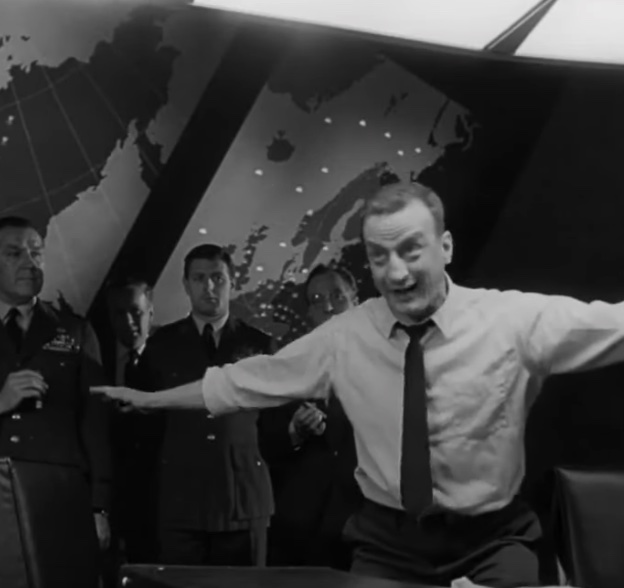
This 1964 movie by Stanley Kubrick is a true classic, which has won numerous awards and recognitions. It differs from the previous two movies because of its clearly satirical intent (and also, because it is not available free online, but in the United States only through Amazon.) The great British comic actor Peter Sellers played three roles in the movie.
The story concerns an unhinged United States Air Force general who orders a first strike nuclear attack on the Soviet Union. It separately follows the President of the United States, his advisors, and a British (RAF) liaison officer as they attempt to prevent the crew of a B-5 from bombing the Soviets and starting a nuclear war. Sellers played the RAF liaison office, U.S. President Merkin Muffley, and Dr. Strangelove himself, who was a deranged, German-American scientist in the U.S. nuclear program who at times cannot hold back his right arm from giving Nazi salutes. (The Strangelove figure was a clear reference to Nazi-era rocket scientist Wernher von Braun who after World War II was speedily recruited by the Americans along with 1,600 other Nazi-era scientists and military engineers to lead up their– our– long-distance rocketry programs.)

Once again, the Wikipedia page on this movie provides very helpful background about its making. We learn there that the movie was loosely based on a book called Red Alert by Peter George, and that while developing the screenplay from the book Kubrick consulted two leading experts in nuclear strategy, Thomas Schelling and Herman Kahn.
Wikipedia adds:
In following the tone of the book, Kubrick originally intended to film the story as a serious drama. However, as he later explained during interviews, he began to see comedy inherent in the idea of mutual assured destruction as he wrote the first draft. Kubrick said: “My idea of doing it as a nightmare comedy came in the early weeks of working on the screenplay. I found that in trying to put meat on the bones and to imagine the scenes fully, one had to keep leaving out of it things which were either absurd or paradoxical, in order to keep it from being funny; and these things seemed to be close to the heart of the scenes in question.”

Kubrick’s use of a “madcap satire” approach to depicting some of the absolutely horrendous aspects of nuclear gamesmanship was paralleled to that used by the singer-songwriter Tom Lehrer at the time. (We’ll be looking at some of Lehrer’s songs in a later post here.) Was such an approach to looking at the prospect of nuclear annihilation inappropriate? Personally, I don’t think so. At the time, and now, I see it as a coping mechanism that can help people to think about, discuss, and plan for what Herman Kahn himself rightly called “the unthinkable.”
Kubrik himself was, as Wikipedia tells us here, keenly attuned to the need to strike the right emotional tone with the movie. An original version of the movie had it ending with a pie fight in the U.S. War Room. But in a 1969 interview, Kubrick said, “I decided it was farce and not consistent with the satiric tone of the rest of the film.” In the final version, the ending shows Dr. Strangelove exclaiming, “Mein Führer, I can walk!” before it cuts to footage of nuclear explosions, with Vera Lynn and an audience evocatively singing “We’ll Meet Again.” The footage, Wikipedia tells us, came from film shot of various actual U.S. nuclear tests in Bikini Atoll and elsewhere. Also, shortly before the film was released, Pres. Kennedy was shot in Dallas. The film had in it a pretty raunchy line from the (deranged-Texan) bombardier about having a fine night out in Dallas. But Kubrik and Columbia Pictures delayed the release of the film and dubbed over the reference to Dallas one to “Vegas”, instead.
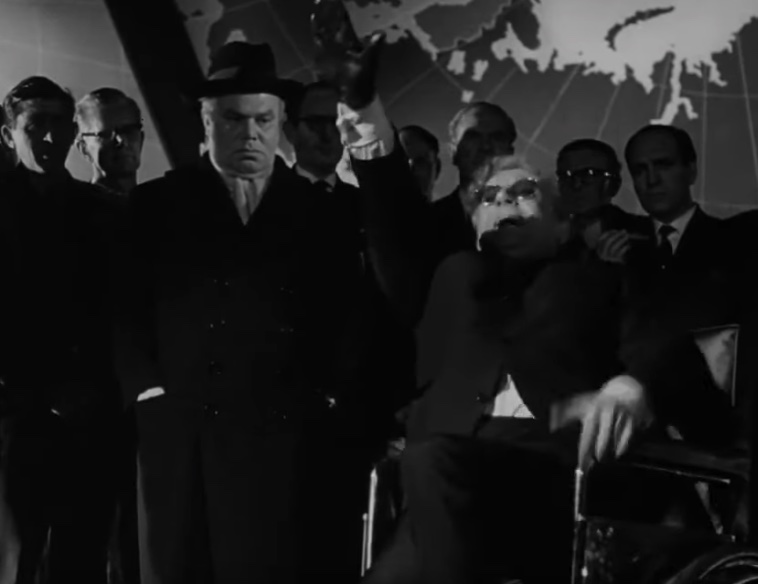
The section of the Wikipedia page on “Satirizing the Cold War” is all definitely worth reading. It notes this:
To rebut early 1960s novels and Hollywood films like Fail-Safe and Dr. Strangelove, which raised questions about US control over nuclear weapons, the Air Force produced a documentary film, SAC Command Post, to demonstrate its responsiveness to presidential command and its tight control over nuclear weapons. However, later academic research into declassified documents showed that U.S. military commanders had been given presidentially-authorized pre-delegation for the use of nuclear weapons during the early Cold War, showing that this aspect of the film’s plot was plausible.

